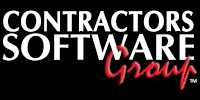Can Remodeling Estimating Software help your remodeling or renovation contracting company?
Today’s working world is all about efficiency and doing more with less. Automation is the name of the game and estimators hardly ever do things by hand anymore. With so many automation tools however, the question has become: What is the best remodeling estimating software for your company?
Using an Excel spreadsheet/Word or using a Database Driven estimating system that will incorporate both estimating and proposal writing into one system
Spreadsheets and Word Processing programs have been around for years and many contractors have built some pretty respectable spreadsheets and legal documents in order to handle their estimating and proposal writing demands.
Database driven estimating systems like from Contractors Software Group take spreadsheets to another level. Most contractors say database driven estimating systems are 3-5 times faster than using Excel spreadsheets and Word.
Database driven estimating systems have the same features as spreadsheets but are able to incorporate and integrate multiple processes and procedures into a single-entry solution, like proposal writing and the creation of budgets, purchase orders, subcontracts, work orders and RFQ’s. They can also can integrate with other systems like Sales, Marketing, Scheduling and Job Cost Accounting software too so you don’t have to enter the same information multiple times.
Another great feature of Contractors Software Group’s remodeling estimating software is that it can also estimate, track and generate customer change orders along with the creation of budgets, purchase orders, subcontracts and work orders associated with those changes.
There are many more processes and procedures that we’ve incorporated into our remodeling estimating software that make spreadsheets obsolete. To find out what they are contact Contractors Software Group at 1-800-866-3083 or sales@csgsoftware.com
You’ll be glad you did!






